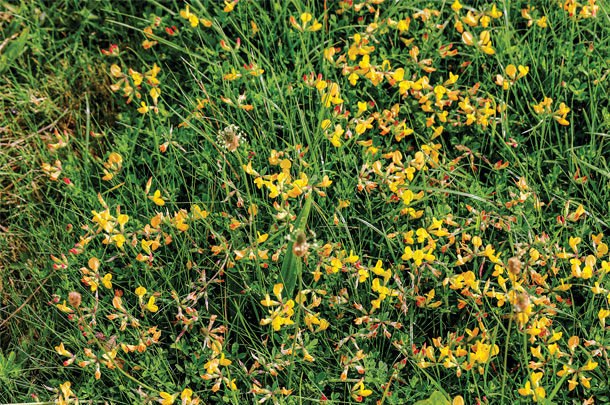Though it never was wildly popular, about a generation ago birdsfoot trefoil began being used even less frequently on dairy farms. Birdsfoot trefoil is a slow-growing forage legume and usually won’t persist when included in a mixed seeding with alfalfa and grass.
This was in spite of a seed mixture of alfalfa + birdsfoot trefoil + cool-season grass continuing to be recommended in 2021 by some state universities.
Alfalfa management on many of today’s progressive dairy farms is a poor fit for an alfalfa-birdsfoot trefoil stand. Farmers have become increasingly aggressive in their alfalfa harvest management, often harvesting second- and third-cut alfalfa at less than 30-day intervals. This is too aggressive for trefoil, which regrows at a slower rate than alfalfa. Perhaps even more important, birdsfoot trefoil needs at least 4 inches of stubble for good regrowth because the leaves on the lower part of the plant are where regrowth starts.
The increased use of disk mowers has resulted in farmers leaving a shorter alfalfa stubble, even in fields where stones are an issue. A 2-inch stubble is OK for alfalfa, which regrows from crown buds, but not for trefoil. Mowing too close to the soil surface and hitting a stone with a sicklebar mower results in immediate “negative reinforcement” when the farmer has to stop to replace a broken mower knife (been there, done that).
Disk mower knives are more rugged and less apt to break and, as farmers realized this, many started leaving a stubble of 2 inches – sometimes even less. Forage analysis data over the past 10 years or so confirms this: Forage ash levels have risen with the increased use of disk mowers and mower-conditioners, and the relegation of the sicklebar mower to the farmer’s iron “boneyard.”
While birdsfoot trefoil isn’t a good fit in alfalfa-based forage systems, it still can have a place on farms. Birdsfoot trefoil (the name comes from the shape of its seedheads) is a high-quality, bloat-proof legume, so it is particularly well-suited for pasture systems. There are two types of birdsfoot trefoil, the so-called “Empire types,” which are primarily used for pasture, and taller European types more commonly used in machine-harvested systems.
In addition to changes in harvest management, another reason trefoil fell out of favor is that the old varieties (primarily Empire and Viking) were highly susceptible to fusarium wilt disease. I was closely involved with the birdsfoot trefoil seed production business in the Champlain Valley of New York and Vermont and was working with trefoil seed producers when this disease hit hard, almost completely wiping out new seedings. With no effective means of control, within a few years this fusarium wilt put Champlain Valley trefoil seed producers out of business.
The good news is that disease-resistant varieties have been developed in both Empire and European types. Pardee, a tall-growing variety intended for hay production, was developed by plant breeders at Cornell University. Pardee is considerably more resistant to fusarium wilt, has faster recovery after harvest and has done well in yield trials. I still don’t think birdsfoot trefoil is a good fit with alfalfa but, especially in somewhat poorly drained soils, may do very well when seeded with a cool-season grass such as tall fescue or meadow fescue.
Meanwhile, Dawn birdsfoot trefoil is a good replacement for Empire, especially where fusarium wilt is a problem. It’s slightly more erect than Empire and not quite as winter hardy, but it has the potential for higher yields in pasture management systems. Birdsfoot trefoil readily self-seeds, so when planted as a pasture legume it can be a self-thickening stand. The USDA recommends a 60-day rest period once every three years which, depending on weather conditions, might be long enough for the plant to produce seed.
Finally, a couple of thoughts on fertilizing trefoil, and these are based on experience instead of research data. In general, you should fertilize birdsfoot trefoil according to recommendations based on soil analysis. These will probably be similar to the recommendations for alfalfa, perhaps moderately less potash because trefoil yields are typically lower than those of alfalfa.
Pay close attention to magnesium levels. Years ago, a university soil fertility specialist told me that, based on his experience, he thought magnesium was very important in trefoil fertilization. If magnesium is deficient and you also need to apply ag lime to increase soil pH, consider using dolomitic lime, which contains more magnesium than “regular” limestone. Otherwise, use a fertilizer source of magnesium such as Sul-po-mag.
But the real wild card may be boron. I’ve seen recommendations to use about two-thirds as much boron per acre when topdressing birdsfoot as you would with alfalfa, as with potash due to lower expected yields. Many years ago, Win Way, long-time extension agronomist at the University of Vermont, had some boron-containing fertilizer left over from a trial he’d been doing. (This was back when farmers were much more interested in using trefoil.) Being a conservative New Englander, he didn’t want the fertilizer to go to waste, so he hand spread the sodium borate on some Empire trefoil growing in a pasture behind his house (no idea of application rate, of course). Win noticed that where he spread the boron, the trefoil responded extremely well. That made him wonder if perhaps this high-quality legume had a greater need for boron. So while this certainly doesn’t qualify as research, if you grow trefoil, I’d suggest you don’t neglect this essential micronutrient (but only as a topdress, never during seeding).
Test, don’t guess – and if soil analysis indicates a need for boron, use at least the amount recommended and maybe slightly more.










